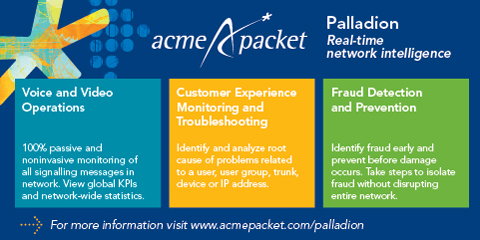More Data, More Problems: Bandwidth Management to the Rescue
2013: the year of video
Operators are going to look toward taming video usage â or at least charge a premium for it â in 2013. In the US Netflix alone has been clocked at consuming more than 30 percent of peak-time bandwidth usage. Video is an application that many carriers will wrestle with in the coming months.
âWe believe 2013 will be the year of the âoperator video-centric strategy,ââ says Allotâs Jonathon Gordon. âTo put it succinctly, operators will take a holistic view of video delivery â which reliably takes up anywhere from 40 to 70 percent of operator networks â including how to optimize the delivery and monetize the experience. Solutions that include traffic management, video optimization and video caching (among others) will be deployed as a single solution, with hooks into the policy and charging systems in the back end and a user portal in the front end that will enable subscribers to personalize their own video experience and price point.â
For example, some customers may want a premium video experience and therefore will be willing to pay a little extra for it, while others may not need access to video at all and wonât want to pay.
âVideo here is an example. This can be extrapolated to other types of content traffic, but video is the obvious contender,â Gordon adds.
Superchannels: where weâre going, we donât need grids
The ongoing strides in fiber-optic network equipment are giving long-ago-installed, long-haul fiber-optic cables a whole new life. First was the recent introduction of 100-gigabit channels to replace the old 10-gigabit standard issue, giving operators 10 times more capacity on each fiber-optic channel.
If that wasnât enough to get excited about, Mark Showalter, marketing director of Infinera, says his company is the only one in the sector shipping 500-gigabit superchannels that allow operators to provision five channels at once, which in turn drives down operating costs. Competitors Huawei, Alcatel and Sierra have announced similar superchannels, but only Infinera has brought them to market, according to Showalter. Next year expect superchannels from all of the players in the space and a resulting huge boost in long-haul capacity as well as lower operating costs and little additional capital expenditures (CAPEX). Not a bad deal.
Moving forward, Showalter says Infinera will soon launch a âgridless superchannelâ that allows the network to take advantage of every color of light on the spectrum rather than being relegated to a specific color, or âgrid.â The standard grid spans about 80 specific colors of light, leaving additional capacity, or âgrid bands,â in between. The industry long ago agreed on a set number of colors for fiber-optic cables to boost interoperability and simplify manufacturing of the gear. The gridless superchannel can take advantage of the unused grid bands while still maintaining interoperability. Once this kind of superchannel is on the market, the existing fiber will have an additional 20-25 percent of increased capacity.





















